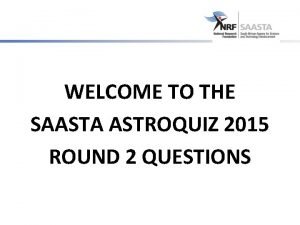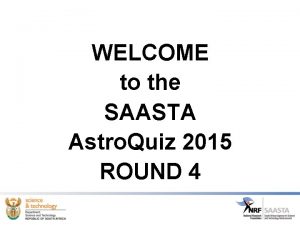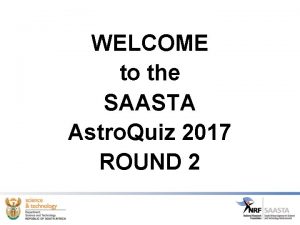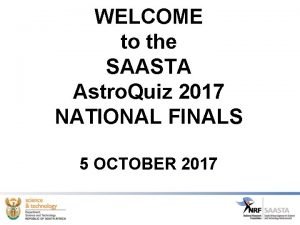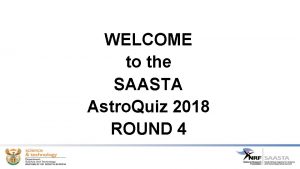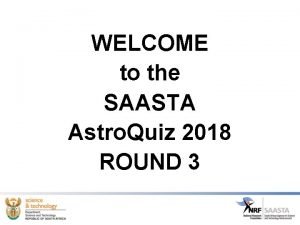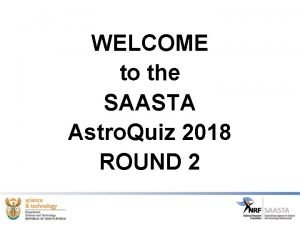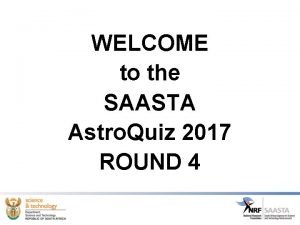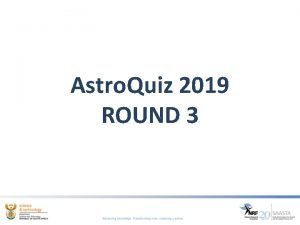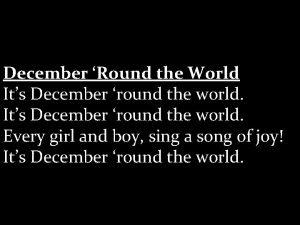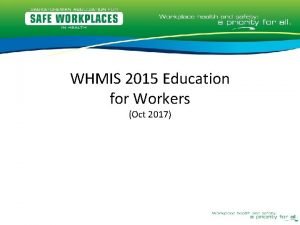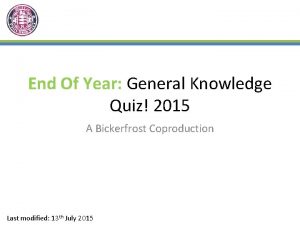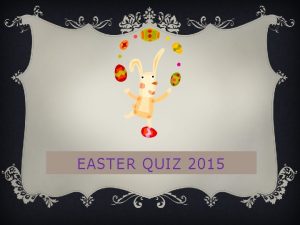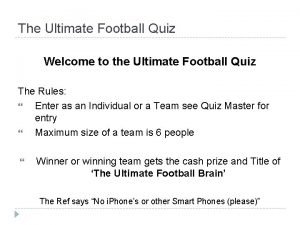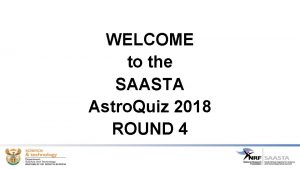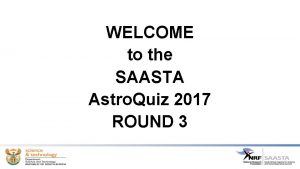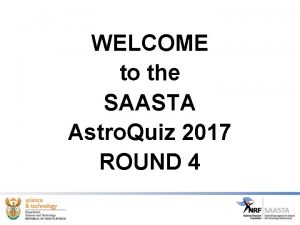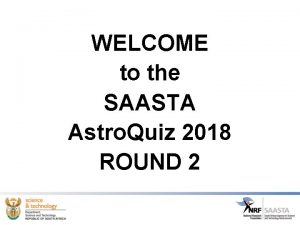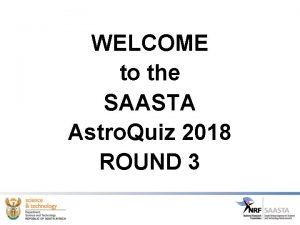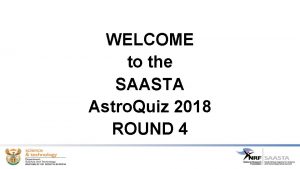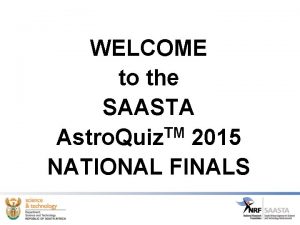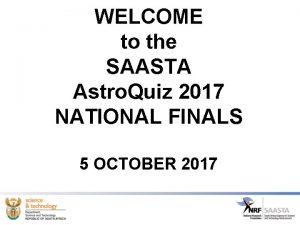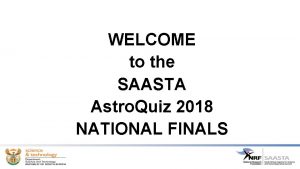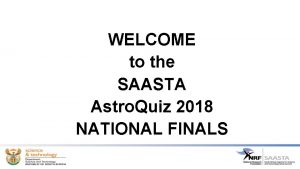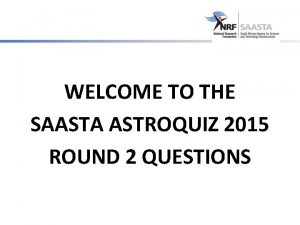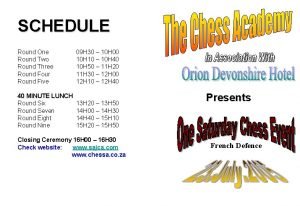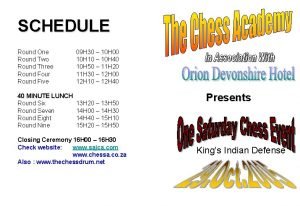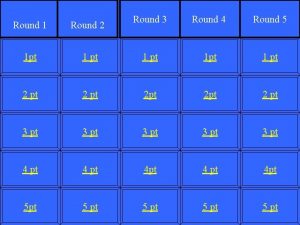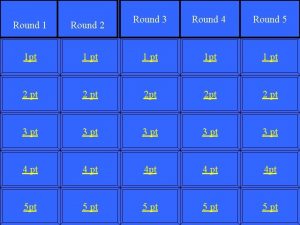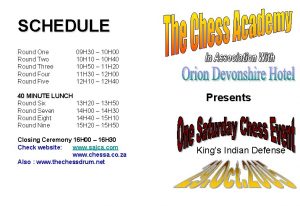WELCOME to the SAASTA Astro Quiz 2015 ROUND







































- Slides: 39

WELCOME to the SAASTA Astro. Quiz 2015 ROUND 3

QUESTION 1 Which of the following is true about Proxima Centauri, the 2 nd closest star to Earth? A. It is a red dwarf and discovered in 1915 B. It is a yellow dwarf and discovered in 1915 C. It is a red dwarf and discovered in 1815 D. It is a yellow dwarf and discovered in 1815

QUESTION 2 The Sun and Sirius are yellow and white stars respectively. Which of the following is true? A. Sirius has a greater star magnitude value than the Sun B. Sirius has a lower star magnitude value than the Sun

QUESTION 3 In a neutron star, electrons and protons are squeezed together to form ____ A. Nuclei B. Neutrons C. Neutrals D. Neutrinos

QUESTION 4 Which of the following planets has zero satellites and is covered with high mountains, valleys & craters? A. Mars B. Venus C. Earth D. Mercury

QUESTION 5 Which spacecraft passed one of the dwarf planets in July 2015? A. Mariner Mark II B. New Horizons C. Viking D. Cassini

QUESTION 6 Which dwarf planet was passed by that spacecraft? A. Ceres B. Eris C. Pluto D. Haumea

QUESTION 7 When was that spacecraft launched? A. January 2006 B. January 2005 C. July 2006 D. July 2005

QUESTION 8 One of the definitions of a Blue Moon is that it is a second full moon in a month. When in 2015 did we have a blue moon? A. July B. June C. May D. August

QUESTION 9 Which two bright planets were seen with the naked eye in the western sky after sunset around June/July 2015? A. B. C. D. Jupiter & Saturn & Venus Jupiter & Mars

QUESTION 10 During which moon phase can we experience a total solar eclipse? A. B. C. D. Full Moon New Moon First Quarter Last Quarter

QUESTION 11 Considering the diameters of Jupiter and that of Earth, approximately how many Earths can one fit inside Jupiter horizontally? A. 11 B. 130 228 C. 0, 09 D. 155 740

QUESTION 12 This planet has satellites, craters and higher mountain peaks than any other planet. Which planet is it? A. Mercury B. Mars C. Venus D. Earth

QUESTION 13 Which celestial body has satellites and a centre of compressed hot liquid of metallic hydrogen? A. Neptune B. Pluto C. Jupiter D. Uranus

QUESTION 14 Which of the following planets is tilted over by approximately 900? A. Earth B. Saturn C. Uranus D. Neptune

QUESTION 15 Which of the following statements about Uranus is false? A. Its diameter is higher than that of Earth B. It is bigger than planet Neptune C. It has 20 satellites discovered so far D. It has lower temperatures than all other known planets

QUESTION 16 The planets of which pair below, represent the biggest planets within their own groups? A. B. C. D. Mercury & Saturn Jupiter & Earth Uranus & Mercury Jupiter & Uranus

QUESTION 17 Approximately how long in Earth years does it take the biggest planet in the solar system to complete one orbit around the Sun? A. B. C. D. 10 12 14 16

QUESTION 18 Earth is approximately 4 times bigger than the Moon and how many times smaller than the second largest planet in the solar system? A. B. C. D. 7 8 9 11

QUESTION 19 Which planet amongst all known ones in the solar system spins on its axis more slowly than all others? A. B. C. D. Mercury Venus Pluto Jupiter

QUESTION 20 Which of the following celestial bodies in the provided “Solar System Fact Sheet” takes the least time to go around the Sun? A. B. C. D. Earth Mercury Pluto The Moon

QUESTION 21 At what speed does Earth go around the Sun? A. 9, 8 km/s B. 11, 2 km/s C. 29, 8 km/s D. 23, 9 km/s

QUESTION 22 Who was the first man in space? A. Alan Shephard B. Yuri Gagarin C. Neil Armstrong D. Mark Shuttelworth

QUESTION 23 In which type of solar eclipse can the ‘diamond ring’ effect occur? A. Partial solar eclipse B. Annular eclipse C. Total solar eclipse D. Doughnut eclipse

QUESTION 24 It is possible to have more than four eclipses in a year. A. True B. False

QUESTION 25 The solar system lies at the centre of the Milky Way Galaxy. A. True B. False

QUESTION 26 Which spiral galaxy is the nearest galaxy to our own? A. Large Magellanic Cloud B. Andromeda C. Triangulum Galaxy D. Small Magellanic Cloud

QUESTION 27 Which of the following is incorrect about the Milky Way and Andromeda Galaxies? A. They are almost similar in shape B. They have dwarf galaxies orbiting them C. They are expected to collide together in future D. They are equidistant from the Earth

QUESTION 28 The Milky Way Galaxy belongs to a collection of galaxies known as ____ A. B. C. D. Local Group Milky Way Galaxy Triangulum Galaxy Small Magellanic Cloud

QUESTION 29 What is the name of the supercluster of galaxies to which the Milky Way belongs? A. B. C. D. Sagittarius Virgo Superfly Coma

QUESTION 30 Which one is the smallest? A. B. C. D. Asteroid The Moon Proton Pluto

THANK YOU FOR PARTICIPATING

SUDDEN DEATH TIE BREAKERS

QUESTION 1 An instrument used to measure movement of a star towards or away from the Earth is ___ A. Microscope B. Stethoscope C. Spectroscope D. Oscilloscope

QUESTION 2 The COBE satellite was the first to measure Cosmic background radiation. A. True B. False

QUESTION 3 Stars never change in their lifetime. A. True B. False

QUESTION 4 What is a starburst galaxy? A. It is a galaxy with bursting stars B. It is a galaxy with very high star birth rate C. It is a galaxy that produces burst of intense light in a regular way D. None of the above

QUESTION 5 A light year is a measure of___ A. B. C. D. Time Light Distance Speed

THANK YOU FOR PARTICIPATING ALL THE BEST!
 Astro quiz round 2
Astro quiz round 2 Saasta astro quiz 2019 round 2 answers
Saasta astro quiz 2019 round 2 answers Astro quiz 2019 questions and answers
Astro quiz 2019 questions and answers Astro quiz 2021 questions and answers
Astro quiz 2021 questions and answers Astro quiz 2018 questions and answers
Astro quiz 2018 questions and answers Astro quiz 2018 answers
Astro quiz 2018 answers Saasta astro quiz 2018 round 1 answers
Saasta astro quiz 2018 round 1 answers Saasta astro quiz 2017 round 2 questions and answers
Saasta astro quiz 2017 round 2 questions and answers Astro quiz 2019 questions and answers pdf
Astro quiz 2019 questions and answers pdf Pickle in the tannenbaum
Pickle in the tannenbaum Exclamation mark pictogram whmis
Exclamation mark pictogram whmis General knowledge quiz 2015
General knowledge quiz 2015 General knowledge quiz 2015
General knowledge quiz 2015 Wise men three clever are we
Wise men three clever are we Ultimate football rules
Ultimate football rules Hát kết hợp bộ gõ cơ thể
Hát kết hợp bộ gõ cơ thể Frameset trong html5
Frameset trong html5 Bổ thể
Bổ thể Tỉ lệ cơ thể trẻ em
Tỉ lệ cơ thể trẻ em Gấu đi như thế nào
Gấu đi như thế nào Tư thế worms-breton
Tư thế worms-breton Hát lên người ơi alleluia
Hát lên người ơi alleluia Các môn thể thao bắt đầu bằng tiếng bóng
Các môn thể thao bắt đầu bằng tiếng bóng Thế nào là hệ số cao nhất
Thế nào là hệ số cao nhất Các châu lục và đại dương trên thế giới
Các châu lục và đại dương trên thế giới Công thức tiính động năng
Công thức tiính động năng Trời xanh đây là của chúng ta thể thơ
Trời xanh đây là của chúng ta thể thơ Mật thư tọa độ 5x5
Mật thư tọa độ 5x5 Làm thế nào để 102-1=99
Làm thế nào để 102-1=99 độ dài liên kết
độ dài liên kết Các châu lục và đại dương trên thế giới
Các châu lục và đại dương trên thế giới Thể thơ truyền thống
Thể thơ truyền thống Quá trình desamine hóa có thể tạo ra
Quá trình desamine hóa có thể tạo ra Một số thể thơ truyền thống
Một số thể thơ truyền thống Cái miệng bé xinh thế chỉ nói điều hay thôi
Cái miệng bé xinh thế chỉ nói điều hay thôi Vẽ hình chiếu vuông góc của vật thể sau
Vẽ hình chiếu vuông góc của vật thể sau Thế nào là sự mỏi cơ
Thế nào là sự mỏi cơ đặc điểm cơ thể của người tối cổ
đặc điểm cơ thể của người tối cổ Thế nào là giọng cùng tên?
Thế nào là giọng cùng tên? Vẽ hình chiếu đứng bằng cạnh của vật thể
Vẽ hình chiếu đứng bằng cạnh của vật thể
